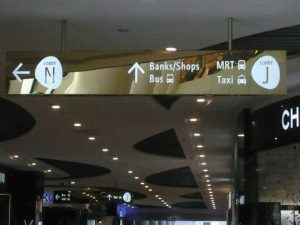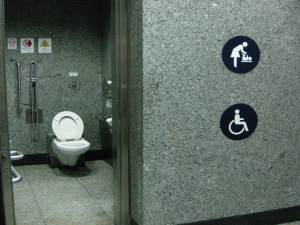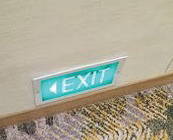Poorly-designed Directional Signage

Directional signage finish reflects light and provides glare

Example of non-glare finish for accessibility signage

Example of fire exit sign located slightly above floor level to guide evacuation
Design Guidelines
- Design work for wayfinding boards should begin with a comprehensive study of the environment, user groups and needs, and user-traffic flow (SS 599:2014). (See also ISO 28564-1:2010).
- Signage should be in a flexible modular system that is consist in design, materials, construction and finish.
- Limit number of variations within the range of sign components in order to enjoy the benefits of economies of scale during production and maintenance [1].
- Specify and ensure that signage face have glare-free finish. In Australia, letters and numbers on signs are required to be in Sans serif [2] or Helvetica medium fonts [3].
Construction Guidelines
- Use sufficiently robust and durable materials with proper construction detailing to withstand the normal wear and tear of signage (SS 599:2014). (See also ISO 28564-1:2010).
- Refer to the minimum illuminance of all areas on signs — 200 lux or approximately 50 lux above the surrounding light level (whichever is greater) for externally illuminated signage; 300 cd/m2 based on the white foreground of the backlit sign-face on internally illuminated (backlit) signs.
- For large-scale developments or where appropriate, signage strategies should preferably be tested in the form of mock-ups and be evaluated with a walk-through as a user before final implementation. [1].
Maintenance Guidelines
- Provide adequate directional signage and provide for mounting, power and data points [4].
- Allow efficient update of signage whenever information is subject to change [1].
- Signage components should also be easy to clean, repair and update (SS 599:2014). (See also ISO 28564-1:2010).
- Formulate a comprehensive strategy for updating, maintenance, control and enforcement, future procurement, and records [1].
- Allow a 200 lux level of illumination on signs when emergency lighting is used [3].
References
[1] Building and Construction Authority (2013). Code on accessibility in the built environment. Singapore: BCA.
[2] United Nations (2017). Accessibility for the Disabled — A Design Manual for a Barrier Free Environment: Urban Design Considerations. Retrieved on March 22 from http://www.un.org/esa/socdev/enable/designm/AD1-07. htm.
[3] Canadian Human Rights Commission (2007). International Best Practices in Universal Design: A Global Review (Rev. ed.). Canada: Canadian Human Rights Commission.
[4] Building and Construction Authority (2007). Universal Design Guidelines. Singapore: BCA.
Normative References/Standards Referred to for Directional Signage
• ISO 28564-1:2010 — Public information guidance systems — Part 1: Design principles and elements requirements for locations plans, maps and diagrams
• SS 599:2014 — Guide for wayfinding signage in public areas